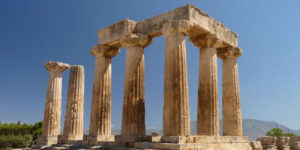Paul’s teaching starts riot in Ephesus
Merchants go berserk with the preaching of the Gospel
Old news? Yes, it was the headline in Ephesus over 2000 years ago. In the New Testament book of Acts it’s recorded that the Lord caused a riot to break out among those who sold idols and pagan works of the goddess Artemis. A group of silversmiths raged against the Apostle Paul and his preaching of the Gospel because they made silver figure-like statues of Artemis, and his preaching hurt their businesses.
Apostle Paul spent three years in Ephesus preaching the Gospel. The presence of Jews in the city at the time of Paul is well documented in the Bible. This place is the most visual application for us to study his ministry and understand the importance of his journey.
Ephesus Roman Free City
During the 1st Century AD, Ephesus prided itself as being the commercial, intellectual, and religious center of the Roman province of Asia. It was the fourth largest city of the Roman Empire after Rome, Alexandria, and Antioch. Ephesus was not the official capital but was recognized as being “the first city” and was granted status by the Romans as a free city. It had an estimated population of 250,000.
At that time the city was considered the center of travel and commerce in the ancient world. Ephesus, one of the greatest sea ports, was situated on the Aegean Sean. During Paul’s time the city had three important roads that served numerous people groups from the largest cities of that time. One road led to Babylon by way of Laodicea. A second road traveled to Smyrna. The third road followed the Meander Valley, which remains an important river to this day.
Library of 12,000 Scrolls
The Celsus Library is one of the most beautiful structures in Ephesus. It was built in 117 A.D. It was a monumental tomb for Gaius Julius Celsus Polemaeanus, the governor of the province of Asia. The library housed over 15,000 scrolls, some of which would have come from Babylon and beyond. The scrolls of the manuscripts were kept in cupboards in niches on the walls. There were double walls behind the bookcases to prevent the them from the extremes of temperature and humidity. The library had three entrance doorways flanked by four statues set back in niches. It was the third richest library in ancient times after the Alexandra and Pergamum and would have had importance.
The Great Theater
The Great Theater of Ephesus is the site of the conflict between Christians and the followers of Artemis. It is considered to be the most imposing, impressive structures of city. Able to seat 25,000 spectators, it consisted of three stories with the second of them having been decorated with pillars, statues and carvings. Apart from the theatrical plays and music performances that took place in the theater, political and religious events were carried out there as well.
The construction of the Ephesus theater may have started during the Hellenistic period. Earthquakes partially destroyed the theater in 4th century, but it was restored and is now used every May for the Ephesus Festival of Culture and Art.
Center for Pagan Rituals
Ephesus was home to the Temple of Artemis, which was dedicated to the goddess Artemis. It was a remarkable construction and is listed as one of the Seven Wonders of the Ancient World. It was completely rebuilt three times before its final destruction in 401 AD. Only foundations and sculptural fragments of the latest of the temples at the site remain.
Worship ceremonies honoring Artemis included religious hysteria, formulaic magic and incantations, sorcery, astrology, and sexual acts. The business of the city was intertwined with its religion, which included mini-amulets to hang around their necks, arms, and ankles.
The Ephesians held an Artemisia Festival each spring, which was an important part of a Greek political and cultural identity. It was essential to the economic life of the region, and considered an excellent opportunity for young, unmarried Greeks of both sexes to seek out marriage partners. Games, contests and theatrical performances were held in the goddess’s name. A magnificent procession through the streets drew huge crowds to the city.
Magical Practices
The Ephesians were greatly addicted to magic and the city was known as center for magical practices. In the center of the Temple of Artemis was a large statue of the goddess. Carved on the status were inscribed symbolic characters, which were believed to possess great power. The Ephesians had many books, called the Ephesian Letters, explaining the meaning and use of these symbols.
These books on divination contained instructions for communication with spirits. They were the regulations of the goddess worship, including directions for soliciting help and obtaining supernatural information. Among those who gave close study to these costly books were many magicians. They wielded a powerful influence over the minds of the superstitious worshipers of the image within the temple.
Paul’s Stay in Ephesus
In his evangelistic travels, Apostle Paul spent time with a Christian community in Ephesus. He preached the Gospel and many were converted.
This became known both to all Jews and Greeks dwelling in Ephesus; and fear fell on them all, and the name of the Lord Jesus was magnified. And many who had believed came confessing and telling their deeds. Also, many of those who had practiced magic brought their books together and burned them in the sight of all. And they counted up the value of them, and it totaled fifty thousand pieces of silver. So the word of the Lord grew mightily and prevailed. Acts 19:17-20
At one point, the Christian converts were so transformed they burned 50,000 pieces of silver worth of magic books and manuscripts. Because of the size and dedication of the Ephesian church it became a threat to the idol-making industry in Ephesus.
The most famous account of Paul’s opposition in Ephesus comes from the Book of Acts, with the riot of the silversmiths following a sermon Paul gave against polytheism:
And the same time there arose no small stir about the Way.
For a certain man named Demetrius, a silversmith, which made silver shrines for Diana, brought no small gain unto the craftsmen; Whom he called together with the workmen of like occupation, and said, Sirs, ye know that by this craft we have our wealth. Moreover ye see and hear, that not alone at Ephesus, but almost throughout all Asia, this Paul hath persuaded and turned away much people, saying that they be no gods, which are made with hands: So that not only this our craft is in danger to be set at nought; but also that the temple of the great goddess Diana should be despised, and her magnificence should be destroyed, whom all Asia and the world worshippeth.
And when they heard these sayings, they were full of wrath, and cried out, saying, Great is Diana of the Ephesians. Acts 19:23-28
Because of the out rage, Paul was brought to the Great Theater of Ephesus where he was judged and found guilty of not respecting the goddess Artemis. He was imprisoned and forced to leave the city.
Message to Church of Ephesus
In Revelation 2, the Church of Ephesus was commended for the things it had done correctly. Jesus tells them in the Revelation that He has something against them. Analyzing this instruction from Christ, we note that Jesus told the members at Ephesus that He knew their works, patience and attitude toward those who practiced evil. Christ knew that a great work had been done in their city and that they had been an example to all of Asia. He also acknowledged that members of this congregation had seen through the words of false teachers claiming to be apostles and had remained faithful to God. After praising the church of Ephesus for the good works it had done, Jesus then told them that He had something against them. They had lost their “first love”
He said that they have left their first love and they should repent. In verses 4 and 5 of Revelation 2, He states that unless they repent and return to their first love, Christ, then He will remove their candlestick from its place. The implication seems to be that if they do not return wholeheartedly to their initial fervor as Christians, then they as a body of believers will cease to exist. It worth noting that the Church at Ephesus has indeed, ceased.
Word for the Church Today
As was apparent in the time of Apostle Paul, it is so today. When one first learns of God’s way of life, it is quite natural to have an excitement and zeal for learning and living by God’s instructions. Over time, however, the new can wear off and one’s excitement for God can fade or dissipate. What happened to the church at Ephesus was over time they began drifting away from God. Christ told them that they needed to repent and do their first works if they wanted to remain a part of the Church of God.
Footsteps of Paul
The Ephesus tour is a favorite on our Footsteps of Paul Cruises and will include in depth teachings on the state of the city of Ephesus during the time of Paul. You will enjoy the sites of the beautiful Mediterranean as our incredible speakers teach their way through some of the most impacting stories of the Bible.
These Christian Cruises with tours are bound to inspire and strengthen your faith as you retrace Paul’s journey. As you look upon unique sites such as these in Ephesus, you will gain a better understanding of the Word and a greater appreciation of the fruits of Paul’s labor. Learn firsthand of the struggles and courage of the early church and see the places where the Gospel was first preached.



